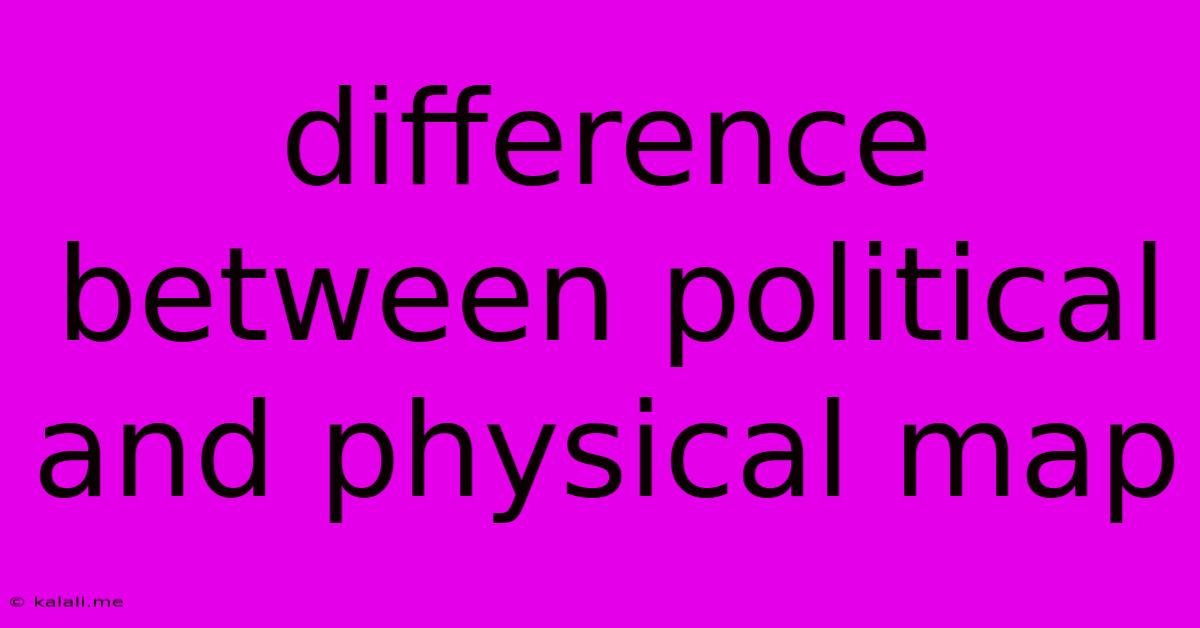Difference Between Political And Physical Map
Kalali
Jun 13, 2025 · 3 min read

Table of Contents
Unveiling the Differences: Political vs. Physical Maps
Understanding the nuances between political and physical maps is crucial for anyone navigating geography, history, or current events. While both types depict geographical locations, their focus and representation differ significantly. This article will delve into the key distinctions, helping you decipher the purpose and information conveyed by each map type. This guide will provide a clear understanding of their differences and uses.
What is a Political Map?
A political map prioritizes the boundaries and divisions created by humans. These boundaries represent countries, states, provinces, counties, and other administrative regions. Think of them as a snapshot of the world's political landscape at a specific point in time. The primary focus is on showing the spatial organization of human-made political entities.
Key Features of Political Maps:
- Boundaries: Clearly defined lines indicating the borders between countries, states, or other political regions.
- Capital Cities: Usually marked with a star or a specific symbol to indicate the location of the main administrative center.
- Major Cities: Other significant urban areas are often labeled, providing a geographical context to population distribution.
- Bodies of Water: While present, these are secondary to the political divisions, often simplified to ensure readability.
- Labels & Names: Countries, states, provinces, and major cities are clearly labeled for easy identification.
- Limited Topography: Physical features like mountains or rivers are often minimized or absent, focusing primarily on human-made boundaries.
What is a Physical Map?
In contrast to political maps, physical maps emphasize the Earth's natural features. They showcase the planet's topography, highlighting landforms like mountains, valleys, plains, and plateaus. They also illustrate the distribution of bodies of water, including oceans, seas, rivers, and lakes. Physical maps give a visual representation of the planet's three-dimensional terrain.
Key Features of Physical Maps:
- Topography: Detailed representation of elevation using contour lines, shading, or relief to show mountains, hills, valleys, and plains.
- Water Bodies: Extensive depiction of oceans, seas, rivers, lakes, and other water features, often using different shades of blue to represent depth.
- Vegetation: Sometimes includes representations of forests, deserts, and other vegetation types.
- Landforms: Clearly displays the various natural land formations, providing a visual representation of the Earth's surface.
- Limited Political Boundaries: While political boundaries may be included, they are secondary to the natural features.
- Color-Coding: Often uses a range of colors to indicate elevation or depth.
Comparing Political and Physical Maps: A Side-by-Side Look
| Feature | Political Map | Physical Map |
|---|---|---|
| Primary Focus | Human-made boundaries & political divisions | Natural features & topography |
| Key Elements | Boundaries, cities, capitals | Landforms, water bodies, elevation |
| Color Use | Often uses distinct colors for countries | Uses colors to represent elevation & terrain |
| Purpose | Show political organization & administration | Show the Earth's physical geography |
Practical Applications of Each Map Type
Understanding the differences is key to choosing the appropriate map. Political maps are essential for understanding geopolitical issues, planning international travel, or studying government structures. Physical maps are invaluable for understanding climate patterns, analyzing potential natural resource locations, or planning outdoor activities like hiking or camping. Often, a topographical map, which combines elements of both, provides the most comprehensive geographical information.
In conclusion, while both political and physical maps serve as visual representations of the Earth, their distinct focuses make them essential tools for different purposes. Learning to differentiate between them empowers you to interpret geographic information more effectively and accurately.
Latest Posts
Latest Posts
-
Difference Between Quality Control And Quality Assurance Pdf
Jun 14, 2025
-
Gpa Requirements For University Of Memphis
Jun 14, 2025
-
What Are The Prime Factors Of 156
Jun 14, 2025
-
Which Of The Following Is A Connectionless Protocol
Jun 14, 2025
-
Cooling Of Magma On Earths Surface
Jun 14, 2025
Related Post
Thank you for visiting our website which covers about Difference Between Political And Physical Map . We hope the information provided has been useful to you. Feel free to contact us if you have any questions or need further assistance. See you next time and don't miss to bookmark.